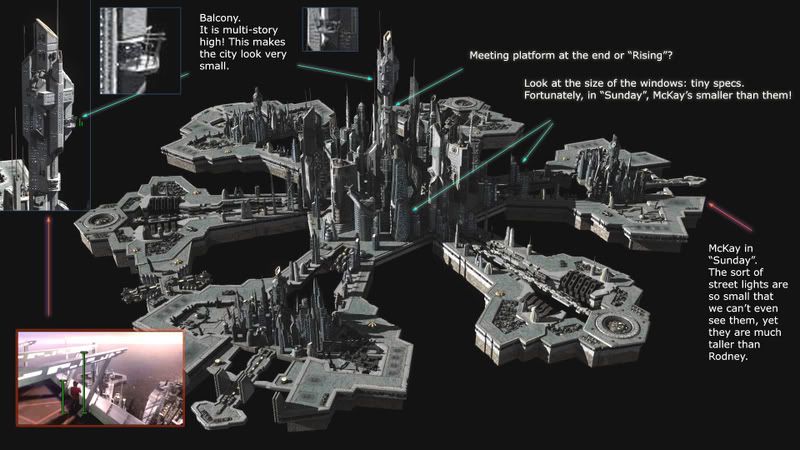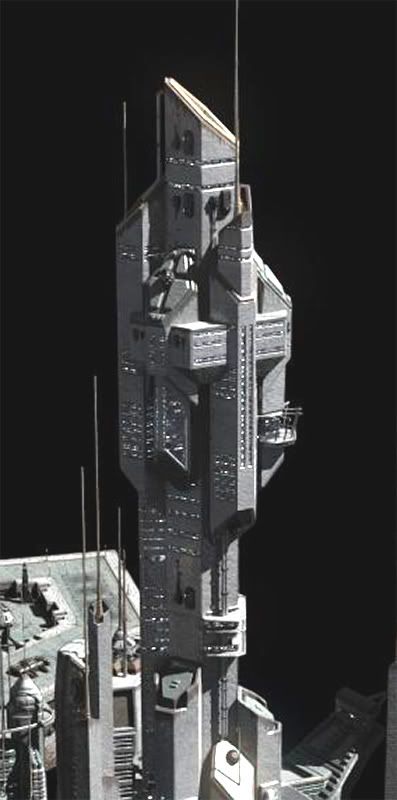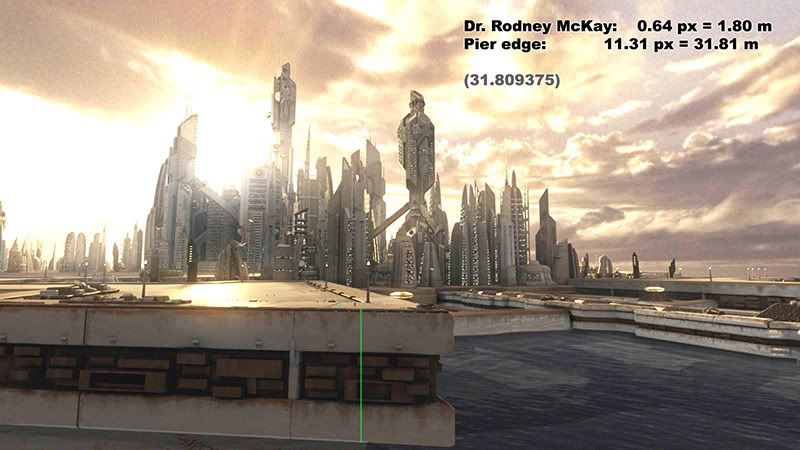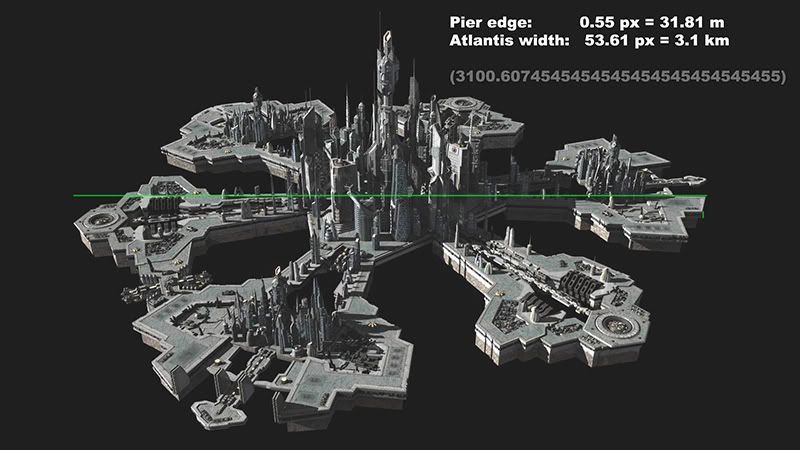For the longest time I’ve been wanting to undertake some larger project, something a little more substantial then the somewhat inane vs. debating threads on SB and the occasional tech thread there.
So I thought that I’d start a weekly Stargate tech thread. Basically, whenever a new episode is released, I’d put down everything important in it in a thread and then we could all have a merry little discussion about it.
So, I thought I’d get a jump-start on this whole thing and start with “Adrift†and “Lifeline†of the fourth season of Stargate Atlantis, now instead of later. The proper episodes haven't been released yet, but there is a whole lot of interesting stuff we learn even with these early unfinished ones which were leaked a while back. I will, of course, update once the real episodes are released.
Any and all comments are welcome.
Alright on to business:
The shields on Atlantis:
There are a number of interesting things we learn about the shields on Atlantis in these episodes. Among them is the fact that shields can apparently be shrunk if the power-output drops too low. This seems to be quite a handy feature, as it allows the ship to maintain shielding around the vital central spire even in emergencies. It also limits the areas that needs life-support, gravity and inertial dampening if the city would happen to be in space at the moment, so presumably power-consumption is cut back quite a bit.
It’s also confirmed near the end of “Lifeline†that the shield starts drawing more power if strain is put on it. I’ve always had a pet theory about Stargate shields that pretty much said this, but now it’s actually canon.
Basically it goes a little like this, we know that you can project stronger and weaker shields by pumping more and less power to them. So just having the shields active would mean it draws a lot of power. But then when the shields are hit with something, the shields start drawing even more power. The problem of how Atlantis radiates the excess energy away arises though. Think of the thousands of years this city lay on the ocean floor for instance, if it was drawing power the whole time, it would’ve had to radiate it away somehow. Maybe channeling the excess heat into subspace? We know they can draw power from subspace, why not into it as well?
The alternate theory I’ve heard is that the shield is simply an energy barrier, you project some energy to it and that’s it, it remains active as long as that initial energy remains in place and it doesn’t need to continuously draw power. Then when something hits the shield, it replenishes shield strength by pumping more energy to it, making it ‘whole’ again.
Atlantis lying on the bottom of the ocean for instance would mean it didn’t draw almost energy at all, as the shield functioned much as a solid wall, rather then a field that continuously needed to draw more power.
The descent to the new home-planet for Atlantis might also merit some shield calculations, but that will have to wait for the real episode to be released. The current copy just has too bad a picture quality to be able to tell exactly what is going on.
However, if my eyes didn’t deceive me, then at one point the city actually seems to be descending so fast that it’s displacing its own entire height per frame. That would mean it was descending several thousand kilometers per second, tens of thousands of kilometer per second even. Wikipedia seems to say that there’s a rule of thumb that says the temperature exhibited on a re-entry craft is the same in Kelvin as the velocity is in meters per second. In other words, if Atlantis was going 10km/s, the temperature would’ve been around 10 000K. Given how large the city is, the total amount of power it had to deflect would’ve been tremendous. However, I don’t know how to get the heat flux from something like this, perhaps someone could help?
One more thing in relation to the high-velocity descent, I’ve recently been looking up on what hypersonic objects would look like inside an atmosphere, and apparently it’s at the 10km/s and upwards mark where one can expect the air to start to ionize behind the object. In other words, a blue trail of plasma would be visible behind it. I don’t think I saw that in the episode, but then again the saturation was all to hell. And I guess the fact that there were shields actually absorbing the heat would put a limit on the ionization.
Atlantis power production:
First, a little background info to keep in mind during all this. The city has apparently had its main power conduits damaged by the Replicator beam, meaning that the city has suffered a serious blow to power production. The city is pumping out massive amounts of energy and most of that goes to waste because of the damaged conduits. This is what caused the ship to drop out of hyperspace too early, there simply wasn't enough power getting to the hyperdrive. The conduits are later on patched, but they aren't able to fully repair them while in space. So everything Atlantis does in these two episodes is bound to be drawing a lot more power then it would under normal circumstances. Even a tiny hyperspace jump was said to have drawn a lot of energy from a nearly full ZPM at the end of “Lifelineâ€.
The power production system also seems to be quite smart. A ZPM that is near depletion apparently refuses to pump out as much power as a fully charged one. Instead, it continuously lowers the power output, instead of power production hitting a sort of wall and shutting down altogether. This could be significant, given that we've seen quite a few ‘nearly depleted’ ZPMs over the years. This feature seems to be built into the city, rather then the ZPM itself though, as we’ve seen a ZPM be drained in a matter of seconds. All in all, this episode once again indicates that a ZPM can really be drained very quickly.
The city, when it detects the lowering power output, decides to decompress the buildings on the outer-piers and turn off the gravity, lifesupport and pretty much everything in them in order to still maintain some shielding around the vital areas.
This gives us some indication to how power-intensive the various systems are in relation to each other. The hyperdrive for instance, is probably the most power intensive of all the major systems, seeing as how it's the first thing to go. Then the shields are shrunk and everything from gravity to life-support is shut down outside of it. It's suggested that drones can still be used though. So the list would be Hyperdrive > Shield-generators > Weaponry on the power-intensity list. Sub-light propulsion and communication was off-line due to damage, but the way the people talked, it seemed they expected these things to still be operational if they hadn’t been damaged.
Atlantis Scaling:
EDIT: Alright, obviously i wasn't seeing straight when i first made this, so i'll just have to correct it a litte.
In this episode there's also a very scalable event on Atlantis itself. We see a puddle jumper leaving the main spire and from that we can get the rough size of the city. The quality of the episode I have is quite bad though, so the real scalings will have to wait for the real episode to be released. However, I have done a preliminary scaling that's meant to do nothing but give us some idea of how big the thing is.
The first step was to scale the puddle-jumper to the top of the central spire. I didn't know the real length of a puddle-jumper, so I put in a place-holder length for when I do the real scaling. To me, 5m would be a fair lower-limit. But perhaps someone else knows a better length? Perhaps you even know of some scalings done on it previously? In any case, the first step in the scaling:

Then comes the second step, getting the width of the city from the top of the spire:

As you can see, this gives us a figure of almost 2.6km, which seems fairly in-line with several of the other scalings I’ve seen around, though a little smaller, to be expected i suppose, given that the jumper has been somewhat nerfed. There's also this picture, that could possibly be used to do a scaling on. It depicts the top of one of the larger spires on one of the piers, and as you can see, Zelenka and Sheppard are barely visible in the shot. In other words, a fairly large building.

Atlantis FTL:
It seems as if the hyperdrive on Atlantis is actually somewhat better then the one on the Apollo, given Carter's comment about how Atlantis should've beaten the Apollo to the new home planet.
In “First Strike†it was said that it would take at least “a few hours†to get to the new home planet. I will go into detail on this at a later stage in this post, but it’s indicated (though not 100% certain) that the distance is at least 2000 light-years. Assuming that by “a few hours†McKay really meant 24 hours, it would give Atlantis a FTL speed of at least 712000c, though probably much faster, since both the time and distance variables I gave were quite ungenerous.
Midway Station:
We also get a first glimpse of the Midway station, the station bridging the Pegasus and Milky Way galaxies via the gate network, in this episode. The station itself seems to be fairly small, perhaps some 100m in length at the most. It hosts the two Stargates and a control room of sorts, and that’s about it.
It’s interesting to note that it’s apparently possible to communicate with the Midway station live from either galaxy. Remember how the gate line is built to function? One gate dials the other and transmits the matter to that one, then that one transmits the matter to the third one etc. This would cause quite a significant lag in the communication, and IIRC then it actually took quite a long time for Sheppard to cross from the Pegasus galaxy to the Milky Way when he was trying. So how do they manage live communication? Perhaps the gates don’t need a fully active wormhole for communications? Perhaps they’ve improved the system to the point where you can now go in on one end and exit the other in very little time at all. Basically, the gates wouldn’t have to shut down and re-dial at all, but the wormhole connecting the all would be one long continuous corridor.
I guess we’ll just have to wait and see. In any case, some images of the thing.


The Apollo:
The Apollo, the new BC-304 we first saw in "First Strike", is back. There's nothing really significant we learn about in this episodes, but there are a few things one might mention.
First off, the communication on the ship is not long-ranged enough to actually reach the Midway station without using the gate-network as a booster, although, considering that the station is placed between the two galaxies, it's not really all that surprising or telling. It does however show that the comm systems on Earth vessels are inferior to that of Asgard vessels. Which is interesting, since the BC-304s are based on Asgard technology.
There's some interesting details on the sensors revealed as well. For one thing, the long-range sensors can't be used while the ship is in hyperspace. The ship basically has to revert to realspace to use them.
Another interesting detail about the sensors is their range. At first, it's theorized that the Apollo would have to make 180 000 small jumps in order to blanket the entire area between Atlantia and the intended new home planet for Atlantis with sensors sweeps. It's also interesting that Carter later finds a way to augment the sensors so that they can actually reduce 180 000 jumps to 50. That would mean that these sensors now have a range that is 3600 times longer then they were before. Quite a significant boost indeed. Or, a more plausible explanation would be that what’s-his-name was actually resorting to some hyperbole when he gave the 180 000 small jumps figure.
Now then, distance between the two planets is unknown. But, like I mentioned earlier, there might be a way to establish a minimum distance between the planets and thus also the sensors. McKay at a later stage in the second episode says that he predicted the Apollo was some 2000 lightyears away from Atlantis. Now Atlantis was traveling in a straight line from Atlantia to the new homeworld, and the Apollo was supposed to meet them there. Since then the two haven’t been in contact, so apparently McKay would’ve assumed that the Apollo was still waiting for them at the rendezvous point. This would indicate that the distance between the two planets would be further, but at least 2000 lightyears. This is not 100% certain, but logically it makes a heck of a lot of sense.
This would mean that the original sensors would have at least a 0.0111 light-year diameter (which is quite small indeed) but the new ones would cover an area at least 200 lightyears in radius. The 0.011 figure, as you can see, is quite ridiculously small, which gives some more merit to the theory that the 180 000 was the result of hyperbole.
The Apollo is also shown to carry at least 7 missiles which it launches at the Asuran ship, probably more though, since there’s much of that scene which is seen from either inside the cockpit of the jumper or the Apollo. What kind of missiles these are is unknown though. They didn’t seem to display the thermal flash which one would expect from nukes, but then again, even what the BC-304s call missiles are far into the megaton-range (perhaps even gigaton) given their displayed effects in “Family Tiesâ€.
Personally, it’s become clear to me that it’s a simple matter of the VFX guys not being interested in adding the great white flashes from the nukes. We’ve seen the nukes so many times now in space, and whenever they hit shields, there is no great white flash.
The Asteroid Belt:
This is one of the most interesting bits in both episodes, and yet, the shot seems to be unfinished and most of it is missing altogether, so there's not a whole lot new to be learned here. There are a few things though.
First, it is suggested that a shielded Atlantis would be able to fly through it if it actually had its shields up. Atlantis, is apparently traveling quite fast as well and unable to decelerate because sub-light drives are damaged. If we get to see how fast the ship is going in the final version of the episode, we might be able to get a calc going on shield strength.
Second, it's suggested that the ancient chair might be able to clear a path through the field. We don't actually see how big these asteroids are, since the scene is missing, but McKay refers to them as 'building-sized or larger'. It's worth saying that in the second episode, we do actually see some of these asteroids, and they appear to be a little bigger then the puddle jumpers, but no more. Of course, that was a very brief segment, so it could be that there were larger pieces which we didn't see.
Thirdly, puddle-jumpers are apparently able to destroy most of these asteroids with their on-board drone weapons. Given the size of the asteroids seen going pop in the second episode, it would indicate that jumper launched drones are around a gigajoule in yield, perhaps more. But like I said, we'll have to wait for the final episode to get anything more substantial out of this.
It’s also interesting to see that there are apparently at least 12 puddle-jumpers fully loaded with drones (at least 4 per jumper) on Atlantis.
Hyperspace travel:
This is quite a trivial bit of information, but I thought speculating on it would be quite nice. Atlantis runs a danger of being ripped apart if it enters hyperspace with insufficient power. I'm guessing this is a throwback to what is said in the first season of SG1, that extreme force is being projected at ships traveling through hyperspace.
Jumper Hyperdrive:
You may remember that McKay in "Tao of Rodney" was able to figure out how to create a hyperdrive for the puddle jumper. Well in this episode, it is revealed that he didn't finish the upgrade, but that it was doable. What results is a hyperdrive with a very limited range, it’s unable to make even a ‘short’ 2000 light-year jump. They were able to jump to Asuras though, but how far that is from where Atlantis was is unknown. It was also a one-way trip, as the hyperdrive burned up too much energy to make a second jump.
Jumper Cloaking
There are two interesting things to note about the cloaking device in these episodes.
First off, they seem quite effective even against civilizations with a high tech-level, as indicated when a Jumper is able to land on Asuras without even being in danger of being detected by at least passive sensor sweeps, though it’s possible that active sensor sweeps might locate it.
Secondly, the cloaks can now apparently be turned into anti-replicator fields. This shouldn’t be too surprising though, seeing as how they basically did the same thing with Atlantis’ shields in “The Returnâ€. The shields in this mode could also be extended quite a bit, which is also a previously seen feat, though the distance they extended in this episode seemed quite a lot larger.
The cloak/shields/AR-field also seems to be a lot less power-intensive then hyperdrives, seeing as how the Jumper didn’t have enough power to actually jump into hyperspace, but did have enough power to cloak and extend the AR field quite a bit. It could be possible to calculate power needed to enter hyperspace simply getting the energy needed to lift the jumper to orbit. This is another thing that would require a scaling of a puddle-jumper, so I might just have to do that myself later on, if there isn’t a scaling available already.
Asuran Ships
There seems to be two different sorts of Asuran ships introduced in the second episode. The first type attacks the Jumper just as it’s taking off from the Asuran homeworld. They fire at the Jumper but cause low damage, indicating that they might be some form of fighter-type craft. The second kind is seen when the Jumper reaches space, and that’s the one I will focus on now. Sheppard’s expression upon seeing this new ship-type also suggests it was something different from what was firing at them at first.
The most noticeable thing about this new ship is that it apparently is able to cloak. This is something quite uncommon for standard capital-ships, though there have been a few incidents with such ships.
Offensively the ship seems to fire slow-moving energy-pulses at a slow rate of fire, though these could be drones as well, it’s hard to tell given the quality of the video I have. What’s most striking about them is that the Apollo can take a short bombardment from them with no apparent problem. This would mean that the ship is offensively much less impressive then Ori ships for instance, quite possibly even somewhere in range of Wraith Hiveships.
Defensively the ship is able to take at least 7 missiles launched from the Apollo (whether these were nukes or not is unknown) as well as railgun fire.
Another striking thing is that the Asurans apparently had a ‘massive fleet’ at their disposal only a short time after they had their construction-yards destroyed by the Apollo.
Since this was a new ship-class, I thought a few pics might be in order:


Wraith
The Wraith are hardly mentioned in these episodes, but there is one interesting tidbit of information about them as well. Towards the end of the second episode, a large fleet of Asuran ships are headed towards a Wraith planet. So even though the Wraith are mostly spaceborne, they do seem to control actual planets as well.







